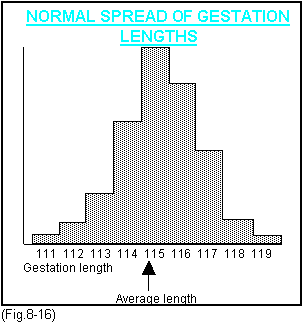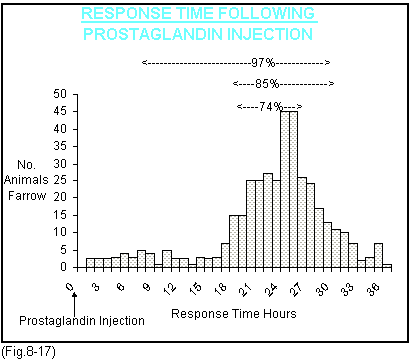



Controlled farrowings
If a sow is injected intramuscularly with the correct dose of prostaglandin from 112 days onwards farrowing will take place approximately 20 to 30 hours afterwards. The use of such medicines can be used to make the time of farrowing in an individual sow or a group of sows more predictable and allow better farrowing management.
- To carry this out on a group basis determine the mean gestation length in the herd.
- Inject the sows on either day 113 or 114 depending on the herd gestation length, by intramuscular injection with the precise recommended dose. The vulva is a common site.
- Always check the mating and farrowing date of each sow.
- Assess the udder of each sow to ensure that she is close to farrowing in case mistakes have been made with the mating date. A good pointer here is that the back quarters of the udder tend to swell and fill up last.
- Inject the sows 24 hours before the required time of farrowing, which is usually early in the morning so that the sow commences farrowing predictably from mid morning the following day. The normal distribution of farrowings and the results following injections are shown in Fig. 8-16 and Fig.8-17.


There are a number of advantages to synchronising farrowings:
- It is possible to prepare the farrowing pens at a more predictable time and increase throughput.
- The sow can be supervised before, during and immediately after farrowing.
- There can be a better use of labour particularly during the evening, nights and the weekends.
- The sow can be managed throughout the whole of the farrowing process and thus any difficulties, stillbirths, savaging or history of previous problems can be monitored.
- The sow can be treated as an individual.
- A considerable amount of care can be given to the piglets immediately after birth, particularly those not breathing well or of low viability.
- All the various management procedures to reduce piglet mortality can be carried out. Gilts which savage their litters can be identified and preventative action taken.
- There can be better use of farrowing houses.
If these advantages are to be gained it is important that people are present to supervise and carry out the management tasks.
There are disadvantages to using prostaglandins:
- Mistakes can occur and the sow can farrow early with weak pigs.
- In some herds there maybe an increase in navel bleeding.
- Wrong timing of the injection may cause problems.
- If there is lack of quiet supervision mortality may be worse, because sows are farrowing during the daytime when there are a considerable number of distractions.
There is also a risk to the pig attendants of accidental self injection which could result in abortion in pregnant women or temporary adverse side effects in non-pregnant women and men. In some countries, prostaglandins can only be used under the supervision of a veterinarian and on veterinary prescription. They should be stored in a locked cupboard under the mangers control and pregnant women should not be allowed to handle them. Procedures for the safe use of prostaglandins are described in chapter 4 Hormones..
The decision whether to use prostaglandins or not must be an individual one based on veterinary advice and the results assessed on each farm. The economics are based on the fact that if one pig is saved per 10 litters farrowed (and this is easily attained by reducing stillbirths by 1 piglet) then the cost of the injections alone will be recovered. The important criterion however is that the extra time and effort should reduce piglet mortality by at least 1/2 a pig a litter.







